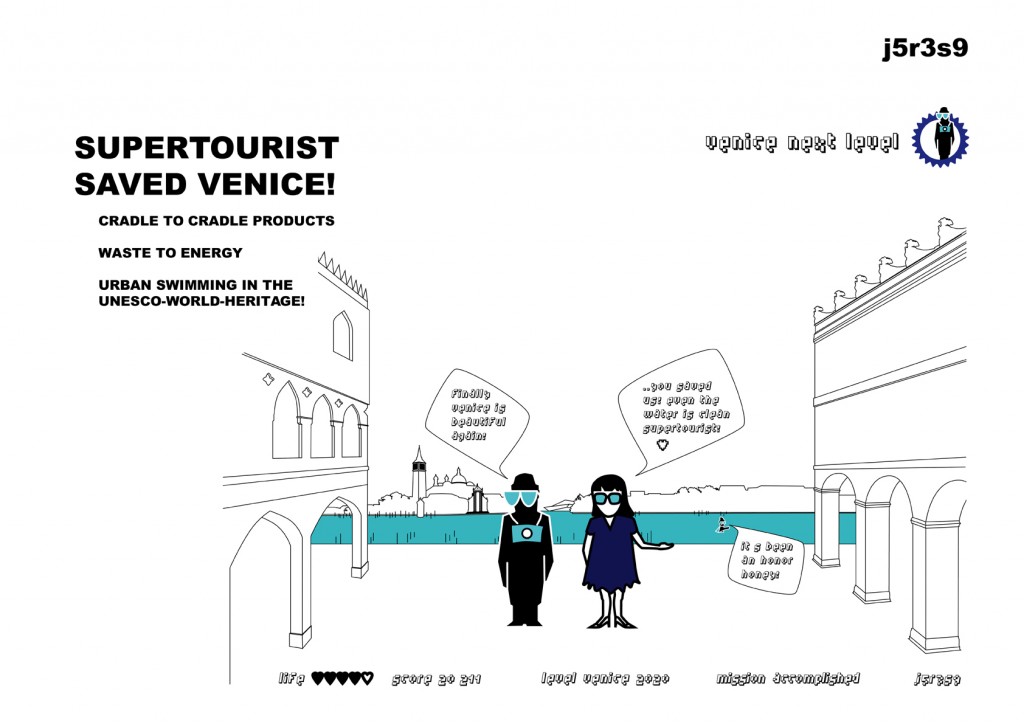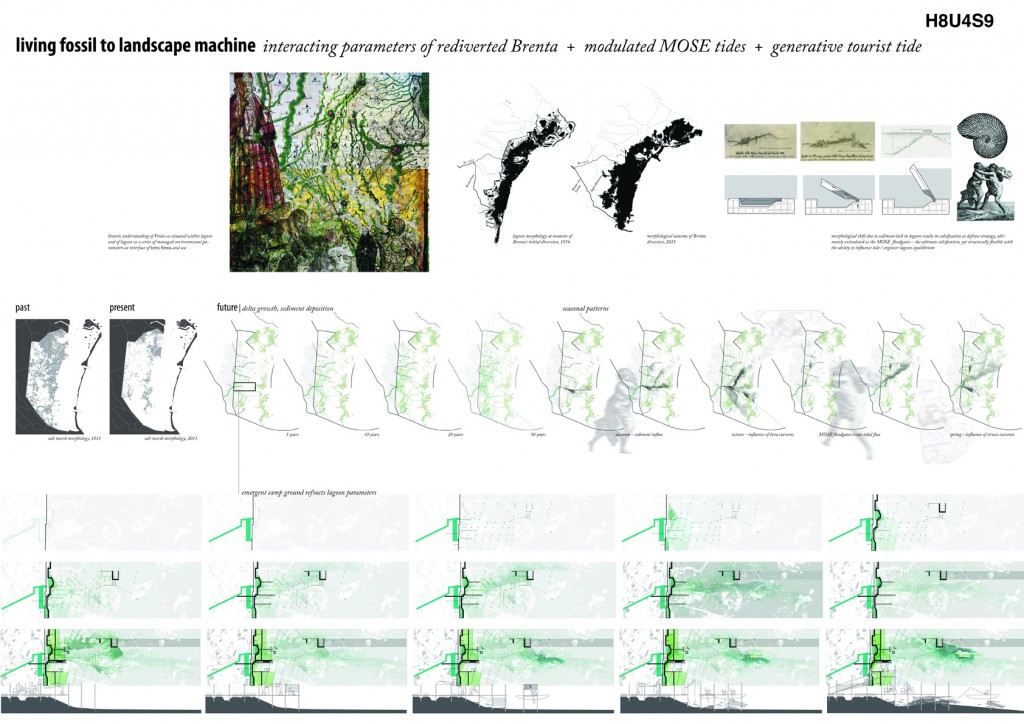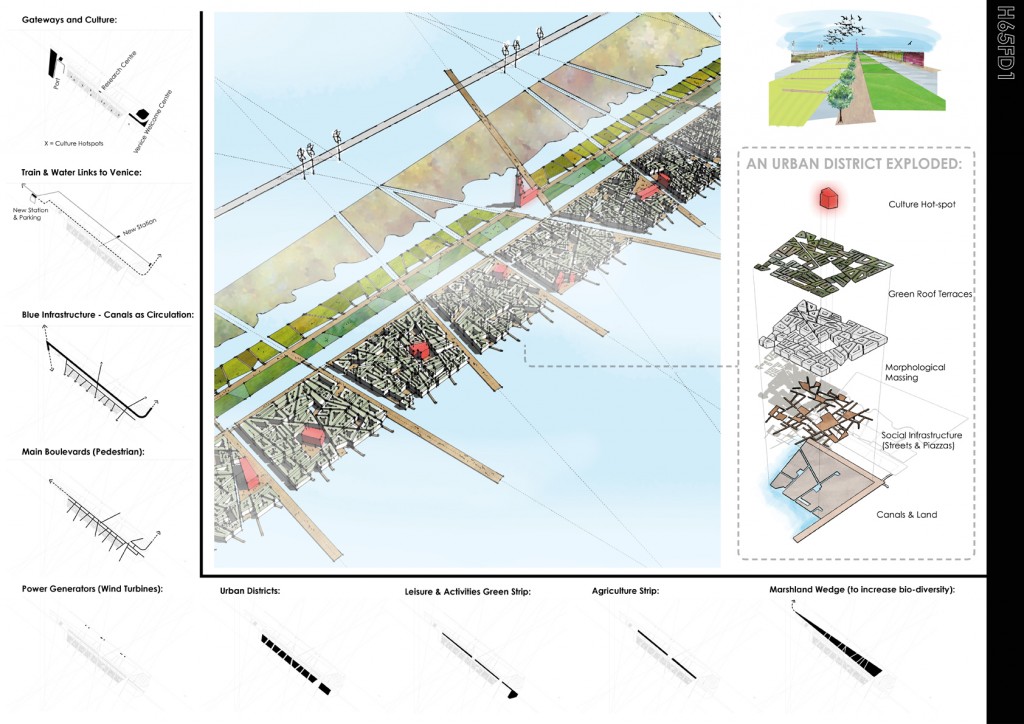Info:
Title: Venice Stripped - Code: H65FD1Contest: Venice / 2011
By: A. Verenini / F. Lemes de Oliveira
Views: 3583 Likes: 2
Votes:
BJARKE INGELS6 NERI OXMAN6 ELENA MANFERDINI8 MARIA LUDOVICA TRAMONTIN3 BOSTJAN VUGA04.6
Venice Stripped
Venice stripped The proposal looks at Venice and its territory. Venice is as an artefact, a pearl of urbanity floating between the Lido di Venezia and Porto Marghera, as if about to escape to the Mediterranean Sea. Its link to the continent, more specifically to Mestre and Marghera, is tenuous and made through Ponte Della Libertà which bisects these areas. Beyond, the territory is marked by agricultural land that pixelates the landscape and organises it. Venice has historically avoided physical link to the land, mostly for military reasons, and developed itself as a centrality on its own right. The duality between the need to protect itself and the need to trade is at the core of Venice’s historical development and reflects its problematic and paradoxical relationship with the terra firme.
Venice is composed of systems, layers of history and modernity. At a morphological level and stripped to its essential features, the city’s main canal, the subsidiary canals, patches of voids, compressed urban blocks, and primary elements (the historically and visually significant urban elements as denoted in Rossi’s seminal book) stand out.
The agricultural land, on the other hand, is a malleable fabric in which the signs of rationalisation appear in the form of pixels. These elements construct the landscape and promote a startling contrast with the picturesqueness and urbanity of Venice.
The proposal
The proposal aims to bridge the gap between Venice and the land. It wants to anchor the city, discuss its relation to the territory without making it loose its marked relation to the water. It is based upon a process of deconstruction of the city and territory to their essential morphological elements, and their reconstruction in the form of a strip.
A physical and metaphorical connection between the continent and Venice is proposed in the form of a strip. The strip uses Venice’s essential building blocks mentioned above as well as a representation of the agricultural land in the form of the pixel. The proposal magnifies the importance of Ponte della Libertà which becomes the north edge of the strip and the directional line along which the different parts of the strip are organised. The strip is comprised of: marshland, agricultural land, a central canal, new urban districts, minor canals and piers and nodes of activities. It is crisscrossed by piers and canals, which sew the water, territory and city together in one cohesive statement.
The marshland occupies the northern area of the proposal and is a buffer zone and an ecological corridor creating habitat for wildlife. The agricultural strip is based on the analysis of the plots in the region and brings food production to the core of Venice’s life. A research centre for food production and promotion of local produce is placed in this part of the strip and becomes its most significant vertical element. The central canal is a continuation of Venice’s most important water feature, extended now all the way to Marghera. The port area is reconfigured to accommodate a reception centre and other uses to attend visitors, as well as to house water taxis and the main ships. This becomes a new entrance to Venice for pedestrians, which are now able to walk from the continent to Venice. On the other side of the promenade, the entrance to the city becomes the entire area between Campo di Marte and the railway station, adapted to form a new gateway. City and country are brought together. Nine new urban districts are created along the main canal providing density to the strip, inhabiting and animating it. These areas are defined by the construction of typologicaly similar blocks to Venice’s, with their own canals, systems of open spaces and cultural core. They have green roofs for the use of residents and rainwater harvesting, and are designed to meet sustainable principles. With regards to energy production, the construction of wind turbines is envisaged as well as the use of photovoltaic panels.
Related Posts :
Comments:
Info:
Title: Venice Stripped
Time: 7 giugno 2011
Category: Venice
Views: 3583 Likes: 2
Tags: A. Verenini , Canal , F. Lemes de Oliveira , Italy , Marghera , Mediterranean , Ponte Della Libertà , Scripps Institution of Oceanography , Veneto , Venice








